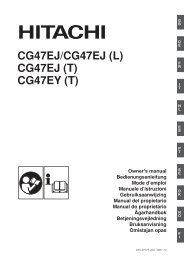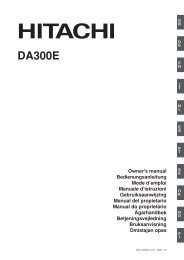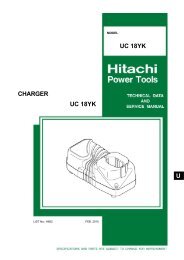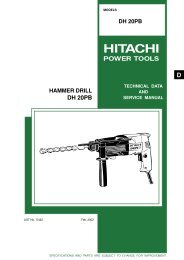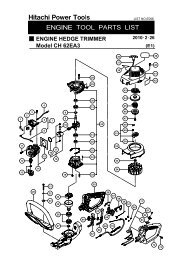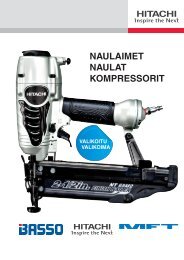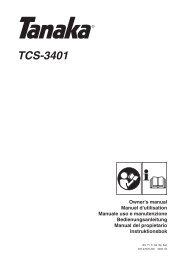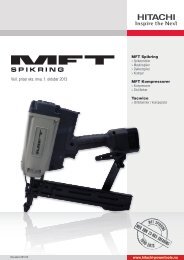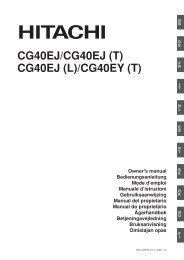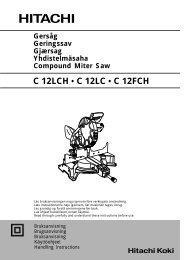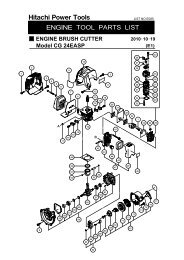CS35EK/CS38EK CS40EK/CS45EK CS33EL/CS38EL ... - Hitachi
CS35EK/CS38EK CS40EK/CS45EK CS33EL/CS38EL ... - Hitachi
CS35EK/CS38EK CS40EK/CS45EK CS33EL/CS38EL ... - Hitachi
Create successful ePaper yourself
Turn your PDF publications into a flip-book with our unique Google optimized e-Paper software.
G<br />
B<br />
Fig. 2-7B<br />
Fig. 2-7C<br />
Fig. 2-7E<br />
Fig. 2-7F<br />
Fig. 2-7D<br />
WARNING!<br />
Never use the saw with only one hand.<br />
You cannot control the saw properly and<br />
you may lose control and injure yourself<br />
severely.<br />
Keep the saw body close to your body to<br />
improve control and reduce strain.<br />
When cutting with the bottom part of the<br />
chain the reactive force will pull the saw<br />
away from you towards the wood you are<br />
cutting.<br />
The saw will control the feeding speed<br />
and sawdust will be directed towards you.<br />
(Fig. 2-7B)<br />
When cutting with the upper part of the<br />
chain the reactive force will push the saw<br />
towards you and away from the wood you<br />
are cutting. (Fig. 2-7C)<br />
WARNING!<br />
There is a risk of kickback if the saw is<br />
pushed far enough so that you begin to cut<br />
with the nose of the bar.<br />
The safest cutting method is to cut with the<br />
bottom part of the chain. Sawing with the<br />
upper part makes it much more difficult to<br />
control the saw and increases the risk of<br />
kickback.<br />
NOTE!<br />
Always keep the spiked bumper face to a tree,<br />
because the chain may suddenly be drawn into<br />
a tree.<br />
FELLING<br />
Felling is more than cutting down a tree. You<br />
must also bring it down as near to an intended<br />
place as possible without damaging the tree or<br />
anything else.<br />
Before felling a tree, carefully consider all<br />
conditions which may effect the intended<br />
direction, such as:<br />
Angle of the tree. Shape of the crown. Snow<br />
load on the crown. Wind conditions. Obstacles<br />
within tree range (e.g., other trees, power lines,<br />
roads, buildings, etc.).<br />
WARNING!<br />
Always observe the general conditions of<br />
the tree. Look for decay and rot in the trunk<br />
which will make it more likely to snap and<br />
start to fall before you expect it.<br />
Look for dry branches, which may break and<br />
hit you when you are working.<br />
Always keep animals and people at least<br />
twice the tree length away while felling.<br />
Clear away shrubs and branches from<br />
around the tree.<br />
Prepare a path of retreat away from the<br />
felling direction.<br />
BASIC RULES FOR FELLING TREES<br />
Normally the felling consists of two main<br />
cutting operations, notching and making the<br />
felling cut.<br />
Start making the upper notch cut on the side of<br />
the tree facing the feeling direction. Look<br />
through the kerf as you saw the lower cut so<br />
you do not saw too deep into the trunk.<br />
The notch should be deep enough to create a<br />
hinge of sufficient width and strength. The<br />
notch opening should be wide enough to direct<br />
the fall of the tree as long as possible.<br />
Saw the felling cut from the other side of the<br />
tree between one and two inches (3-5 cm)<br />
above the edge of the notch. (Fig. 2-7D)<br />
Never saw completely through the trunk.<br />
Always leave a hinge.<br />
The hinge guides the tree. If the trunk is<br />
completely cut through, you lose control over<br />
the felling direction.<br />
Insert a wedge or a felling lever in the cut well<br />
before the tree becomes unstable and starts to<br />
move. This will prevent the guide bar from<br />
binding in the felling cut if you have misjudged<br />
the falling direction. Make sure no people have<br />
come into the range of the falling tree before<br />
you push it over.<br />
FELLING CUT, TRUNK DIAMETER MORE<br />
THAN TWICE GUIDE BAR LENGTH<br />
Cut a large, wide notch. Then cut a recess into<br />
the center of the notch. Always leave a hinge<br />
on both sides of the center cut. (Fig. 2-7E)<br />
Complete the felling cut by sawing around the<br />
trunk as in the Fig. 2-7F.<br />
WARNINGI<br />
These methods are extremely dangerous<br />
because they involve the use of the nose of<br />
guide bar and can result in kickback. Only<br />
properly trained professionals should attempt<br />
these techniques.<br />
GB-9



